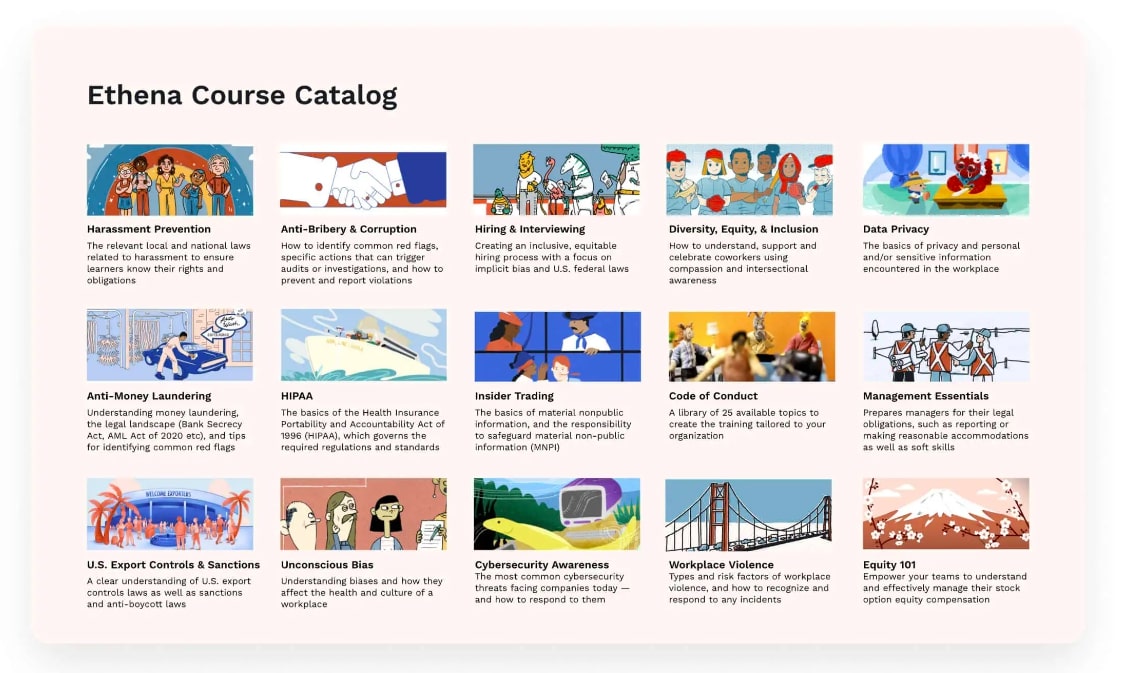10 growth-oriented development ideas for employees

Today’s job seekers are looking for roles with more development opportunities. They want to fill their current knowledge gaps and improve their skills, especially as more companies look for talent with AI and technical experience (1). They’re also equally interested in internal mobility and favor organizations that support them in building and pursuing long-term career paths, with 21% of employees citing a lack of development opportunities as a reason to leave their current roles (2).
If growth-oriented organizations want to rise to the challenge, they need to approach professional development holistically. It’s essential to find ways to incorporate staff development ideas into regular practices like performance reviews, goal-setting processes, and meetings. They must also leverage their existing resources, calling on managers to serve as coaches and mentors and drawing upon in-house expertise to create employee-centric learning courses.
Bringing all that together takes creativity and strategy but doesn’t require a completely new approach. In this article, we’ll explore ten growth-oriented staff development ideas to add to your toolbox.
- Fortune, 2023
- Leapsome State of People Enablement, 2023
🚀 Make employee development central to your company culture
Leapsome’s Competency Framework module allows you to build clear development matrices so every employee in your organization knows what skills they need to reach the next level.
👉 Learn more
The importance of professional growth
Professional growth benefits everyone at all levels of your organization, and it’s especially crucial for companies that value keeping their teams lean and promoting from within.
From the employee perspective, professional growth helps people feel more satisfied and confident in their long-term career advancement. That’s why 84% of employees say they expect their company to provide the training opportunities they need to keep up with the changing demand for skill sets in their industries, according to a survey from edX.
The same data shows that 49% of executives agree that their teams’ current skills won’t be relevant by 2025. That means prioritizing professional growth is urgent for organizations that want to avoid turnover while staying competitive in an ever-changing technological landscape.
“Continuous and lifelong learning will become even more important with the fast pace of technological advancements,” writes L&D expert Hendrik Dietrich in a piece for SHRM. “Learning as a social activity, through peer interactions, mentoring, and collaborative projects, will continue to be a key trend. It fosters communication, teamwork, and problem-solving skills.”
What are some examples of ideas for professional development?
Implementing creative professional development ideas can enhance your company's productivity, collaboration, and innovation. Some examples include:
- One-on-one meetings between team leads and direct reports
- Development-focused performance reviews
- More collaborative team goals
- Shadowing and mentorship
- Bite-sized training courses
- Employee-led learning
10 staff development activities for your people-first business
Employee learning opportunities don’t always take the form of traditional training courses or programs. With that in mind, here are ten innovative staff development ideas you can use as inspiration to design your own initiatives.
📈 Boost employee engagement and retention with our development tools
Leapsome’s Competency Framework tool integrates with our Reviews module, empowering you to create visual career roadmaps and skills profiles for all team members.
👉 Learn more
1. Conduct regular one-on-one meetings

One-on-one meetings don’t only exist for managers to lead performance reviews or give difficult feedback. If team leads use them too sparingly and solely to address major issues, they run the risk of their reports disliking the meeting experience altogether.
Ongoing individual coaching is central to what managers do. Making time to discuss career development regularly can help build trust and psychological safety among employees in addition to guiding them along their career paths.
So, how can you make themes for professional development a bigger part of your regular one-on-one meetings?
- Create a roadmap for your career development talks — Your roadmap will help you stay on schedule and follow the same format each time. Decide how often your talks should occur, how long they should last, and your discussion format.
- Work together on the agenda — Invite your report to the meeting and let them know what you’d like to discuss in advance. Collaborate on what you’ll talk about, or ask the team member to prepare a list of their own agenda points. This gives them more ownership over the process.
- Host the career development conversation — Listen actively to your direct report, ask clarifying questions, and only offer your perspective once you’ve heard and understood what they have to say. Try to stick to your agenda points, but don’t let that impede the natural flow of conversation.
- Come up with action steps — At the end of your meeting, create a list of short- and long-term strategies your report can implement next. Use the SMART goals framework to ensure they’re specific, measurable, attainable, relevant, and time-bound.
🤝 Make your 1:1s collaborative and agenda-driven
With Leapsome, you can build meeting agendas, share notes, and store unresolved talking points on the same platform.
👉 Learn more
2. Invest in improving soft skills
61% of professionals say soft skills matter just as much as hard skills. Because, unlike hard skills, soft skills like communication, leadership, and problem-solving are more transferable and give you greater career longevity. They also prepare you to take on more complex projects and roles in the future.
Common soft skills that organizations value include:
- Leadership
- Communication
- Problem-solving
- Time management
- Innovation
- Flexibility and adaptability
- Assertiveness
- Empathy
So, how can you incorporate more soft skills development into your professional development activities for employees? One idea is using competency frameworks, which should lay out the skills employees need to develop before they advance to the next level in their careers. You can review these frameworks during your one-on-one meetings and performance reviews.
Leapsome integrates competency frameworks with our Reviews and Goals modules, which means managers or direct reports can check their competency profiles or OKRs asynchronously to track progress with specific skills.
.png)
3. Make your performance reviews count
Reviews and development should be interconnected for optimal professional growth. However, many individuals fear performance appraisals or believe they only exist for the benefit of the organization and not to help employees thrive.
Empathetic, competent managers can turn performance reviews into constructive staff development activities, transforming them into opportunities for employees to identify development opportunities and formulate growth plans in a safe space.
In addition to discussing recent employee wins, strengths, and areas for improvement, managers should use assessment forms and discussions to address:
- Professional goals for the next review cycle or quarter
- The position(s) the employee would like to have next
- The skills the employee would need for that position
- The biggest obstacle(s) to the employee advancing to the next level
- What kind of support the employee needs to move forward or laterally
- The career trajectory they’re interested in, exploring whether they want to manage a team or hone their skills as an expert in a specific area
💡 Creating career progression frameworks for employees is crucial to making performance reviews more focused, actionable, and unbiased. If you’ve never experimented with a career progression framework, downloading our free template is a great way to start!
4. Promote structured goal-setting

If you’re a manager, you may have already encountered employees who had a clear vision of where they wanted to go in their careers but weren’t sure how to set the right goals to get there. Professionals who want to advance into leadership roles must learn how to implement goals for themselves and their teams. That’s why practicing goal-setting with direct reports is one of our recommended activities for staff development.
When teaching employees about structured goal-setting, strategic planning models — frameworks businesses use for establishing objectives and driving results — can be useful. These include:
- The OKR framework. Employees set ambitious objectives along with three to five key results they need to accomplish to achieve their overarching goal.
- A SWOT analysis. Team members identify the current strengths, weaknesses, opportunities, and threats they must overcome to reach their objectives.
- The Theory of Change model. Employees determine long-term goals and reverse-engineer them, identifying all the steps they need to take to achieve success.
- The SMART goal-setting approach. Staff members establish goals that are specific, measurable, attainable, relevant, and time-bound.
5. Collaborate on team goals
One of the best growth ideas for colleagues that allows them to gain practice with communication, leadership, and problem-solving is to work together on team goals and OKRs. This works especially well for organizations that use the cascading goal methodology to create objectives that work from the top down.
Once your organization has established its parent goals for the year, team leads and members can:
- Choose three to five team objectives for each quarter (or whatever timeframe your company is working with). They should be ambitious but achievable.
- Create three to five key results for each of your objectives. Your key results should have deadlines and be more specific and actionable than your objectives.
- Make sure each of your key results has an owner. The owner or directly responsible individual (DRI) will track its progress, address obstacles to completion, and push it forward.
- Monitor key results. Team leads should schedule a weekly or biweekly OKR check-in meeting to discuss progress and possible blockers to success, and set goals to advance key results. Keep in mind that the goal is progress, not 100% success.
%2520(1).png)
6. Make shadowing a regular practice
Organizations may make job shadowing part of their initial onboarding process or take advantage of it when an employee expresses interest in advancing to another role. However, shadowing is one of the easiest, lowest-cost staff development ideas companies can implement for team members looking to build specific technical or soft skills.
For internal shadowing to have the most impact, it’s best to build a dedicated framework or program around it. Here’s an example of how that could look and the steps you can take to get there:
- The team lead and their report discuss the skills they’d like to build and the shadowing opportunities they’re interested in.
- The team lead reaches out to potential mentor candidates and communicates why the employee is interested, how long the shadowing would last, and the main goals of the initiative.
- The mentor and the shadower get together and agree on the tasks and skills they’ll work on.
- The shadower lets other team leads and colleagues know about the professional development initiative to avoid bottlenecks and make everyone aware of what’s happening.
- After the shadowing period is over, the manager, mentor, and shadower meet to discuss how the process went, what worked, what didn’t, and how the skills the shadowing employee wanted to develop came along.
7. Experiment with bite-sized learning
Employees have lots of demands on their time. And, as modern learners, their attention spans are short. But with learning modules that range between one and fifteen minutes, bite-sized learning — also known as microlearning — is ideal for busy teams that don’t have much time to spend on long training courses.
Think of the way LinkedIn has become known for educational long-form posts and upskilling videos. Leaders looking for creative staff development training ideas can take advantage of this approach to engage employees and build continuous learning into their company culture.
When exploring bite-sized learning for your company, we suggest you:
- Create a regular learning plan — Whether you share short learning modules with your employees on Slack or Microsoft Teams once a month, or embed educational videos into your company newsletter, it’s better to choose one delivery format and stick to it. You can also create bite-sized training programs for different subject areas that employees can access and complete when it’s convenient for them.
- Start with free resources from Open University, LinkedIn, or even YouTube — Don’t feel the need to invest in costly learning courses or elearning products before you know what works for your people and your business.
- Make it part of other training — For instance, you could host a one-day development seminar or conference and ask employees to commit to watching and completing short modules on their own time. That way, your development training doesn’t have to last longer than a day, cutting down on the time and resources you have to invest.
💡 Looking for microlearning content in the field of people enablement?
As an HR thought leader on LinkedIn, Leapsome loves to experiment with bite-sized learning.
👉 Follow us
8. Launch a mentorship program

Mentoring programs are low-cost ways to develop employees and create more inclusive work environments
If you’re looking for cost-effective ways to engage and develop your remote employees, a mentoring program is a great option. It’s also a powerful way to create a more inclusive work experience for women and people from underrepresented groups, who tend to struggle with finding mentors more than their white male counterparts.
And like other employee development programs, once created, your mentorship program will continue to benefit your employees without much maintenance or time investment. You’ll only have to help coordinate, review, and update it regularly.
To launch your mentorship program, you’ll need to gauge mentor interest levels first. Reach out to anyone who’s qualified for a mentorship role and may have the time and desire to participate. Then, determine how many employees might be interested in getting paired with a mentor.
Once you know the demand for your program, survey the employees looking for mentors about their preferences and the skills they want to develop. Then, match staff members with the mentor that aligns with their needs and interests most closely and have them schedule a first meeting. That gives both parties a dedicated space to decide on goals, meeting cadence, and duration.
9. Embrace employee-led learning
Companies typically offer tuition reimbursement programs to employees so their people will be motivated to learn skills that’ll benefit the company. But tuition reimbursement has the added benefit of letting employees take the lead in their career pathing.
It’s worth noting, though, that people may fail to take advantage of these staff development ideas because they either don’t know they exist or don’t have time to take part in continuing education courses outside of work.
A tool like Learnerbly can provide a creative solution to this problem. As a curated learning marketplace for professionals, Learnerbly offers books, courses, podcasts, and elearning resources. A Learnerbly account lets you allocate a personal learning budget to all your employees, allows them to check how much they have left to spend, and provides tailored learning recommendations to you based on preferences.
.webp)
If you already have great content you’d like to implement for employee-led learning, you can use Leapsome’s Learning module to set up individualized learning paths. With our Learning module, you can seamlessly embed LinkedIn Learning courses, e-learning products, and other learning elements into a fully customizable curriculum. What’s more, our built-in Learning Marketplace allows you to take advantage of high-quality compliance training from top-notch compliance providers like Ethena and lawpilots.

10. Encourage team members to lead meetings
For employees who want to focus on building their leadership skills, taking charge of training and team meetings can be a great way to bolster their confidence and gain experience. An excellent starting point would be letting your team members lead a regularly scheduled department meeting. Why? Because they’re familiar with the format and already comfortable with their colleagues.
If you make this a consistent part of your staff development ideas and strategies, be sure to standardize your process for employees interested in leading meetings. You could follow this routine:
- The designated meeting leader sends colleagues a message a day ahead, reminding them to add any talking points they want to cover to the meeting agenda. If you use a platform like Leapsome for your one-on-one and team meetings, the weekly agenda template can help you fill it out faster.
- The designated meeting leader determines the focus of the meeting, which is what you’ll spend most of it discussing. For example, they may want to prioritize brainstorming ideas for future training, addressing a major issue, or exchanging updates on project progress.
- During the meeting, the designated meeting leader should keep track of time. It’s ideal to end meetings five minutes early so people can stretch or go to the bathroom before logging into another meeting or entering focus mode.
- The designated meeting leader should dedicate some time to praise and recognition, which boosts morale and encourages employees to improve their performance.
%2520(1).png)
Put these ideas for career development to good use with Leapsome
%2520(1).png)
When it comes to incorporating more staff development ideas into your processes, it’s important to consider your organization’s business and revenue goals. However, you shouldn’t prioritize your strategic objectives over your people’s needs.
With Leapsome, you don’t have to choose between organizational and employee goals. Our Competency Framework module allows you to create dedicated competency frameworks for every role, clearly defining what employees need to do to excel at every level. Our holistic people enablement platform also empowers you to:
- Connect competency frameworks with our Reviews module so you can track employee progress with specific skills
- Collaborate and track progress with employee development objectives by syncing your competency frameworks to our Goals module
- Easily identify skills gaps and turn them into self-paced training courses with our Learning module
Leapsome is a platform that not only helps you identify where team members need to grow — it also gives you the tools to develop your people and drive more business success.
🔥 Invest in high-performing teams and a resilient organization with Leapsome
With our Competency Framework module, your team members know what skills they need to work on before their performance review.
👉 Book a demo
Sind Sie bereit, Ihre Strategie zur Mitarbeiterförderung zu verbessern?
your People operations?
Informieren Sie sich über unsere Leistungsbeurteilungen, Ziele und OKRs, Engagement-Umfragen, Onboarding und mehr.
.webp)
.webp)
 Fordern Sie noch heute eine Demo an
Fordern Sie noch heute eine Demo an































